
Unless it encounters a predator or parasitoid or another life-threatening factor, the egg will usually hatch 3 to 4 days after Mama Monarch deposits it beneath a milkweed leaf. As you know, monarchs lay their eggs only on milkweed, their host plant.
If you enjoy macro photography, it's a delight to photograph an egg with a highly specialized lens like the Canon MPE-65mm lens. Or you can observe the tiny egg with a magnifying glass or microscope.
How do you rear it?
Naturalist Greg Kareofelas, an associate of the Bohart Museum of Entomology at the University of California, does it this way:
"I put a single egg on its leaf in a small salsa container (the little plastic ones you would get at a Mexican restaurant). I take a square of toilet paper and fold it into a small square (3/4 of inch), dampen it and squeeze it so it is not sopping wet, just damp, and set the leaf and egg on the top. Put the lid tightly on the container. This keeps a level of moisture in the container. I check the containers daily, changing the toilet paper square to keep from molding."
"I raise the larva in that container until it gets big enough to move to a larger container. As long as you pay attention and check them often to make sure there is no mold or such, I have raised many this way successfully. The tight lid and slight moisture keeps the food plant fresher."
"You don't want loose water in the container, just enough so it is not dry," he says.
Among the many species of butterflies he's reared: the dogface butterfly or California state insect, Zerene eurydice; the Colias behrii, the Behr's sulphur or Sierra green sulfur; and the monarch, Danaus plexippus.
When our family rears monarchs, we usually begin with the caterpillars instead of the eggs. They're easier to find and collect. However, if you see a monarch laying her eggs, you know exactly where to look! Last weekend we watched a monarch deposit her eggs on our tropical milkweed, Asclepias curassavica, and our narrow-leaf milkweed, Asclepias fascicularis. We collected three eggs from the fascicularis and let the others be.
An adult monarch can lay about 400 eggs in her lifetime, Kareofelas says. Only a few survive due to predators and parasitoids and other factors. The major parasitoid in our garden is the tachinid fly which lays its eggs in or on the host or deposits its eggs on the milkweed leaves.
"If you start with the egg, the chance of it being parasitized is really small," says Kareofelas, who has been rearing butterflies most of his life, and especially for the last 15 years.
When the egg hatches into a larva or caterpillar, the 'cat will eat the eggshell first and then go about munching the milkweed. When it gets bigger, it's time to move it into a larger container. You must keep the milkweed fresh, as it can dry out quickly. Kareofelas likes to use water-filled floral tubes and dampened packing foam to keep the leaves/stems moist.
Our family's procedure to rear caterpillars: fill a heavy, wide-bottomed, narrow-necked tequila bottle with water, add sprigs of milkweed and the 'cats, and place in a zippered, net butterfly habitat. We place ours in our kitchen, a tachnid-free environment! Those tachnids can be sneaky! Also, replenish your milkweed and water daily, and remove the frass (excreta) daily.
It's a joy watching the complete metamorphosis, about a 30-day development from egg to larva to chrysalis to adult. The larval stage or caterpillar stage usually lasts 10 to 14 days, during which time the caterpillar will go through five instars (when it molts or sheds it skin). The 'cat will then form a "j" and pupate. The chrysalis stage lasts about 10 to 14 days, and voila! The familiar monarch icon ecloses and it's released back into the garden to start the cycle all over again.
Yes, it's a joy to watch them. But it's not a joy watching a tachnid-infested monarch caterpillar or a chrysalis. (We'd rather the tachnids lay their eggs in such pests as cabbage loopers or tomato hornworms.)
A good place to see butterfly specimens from all over the world is the Bohart Museum of Entomology (now temporarily closed due to the COVID-19 pandemic. Of the nearly eight million specimens in the Bohart, some 500,000 are in the Lepidoptera collection, curated by entomologist Jeff Smith. He and Kareofelas display and discuss the Lepidopterans during the open houses. In the meantime, watch the moth-butterfly videos on the Bohart Museum page.)
Attached Images:
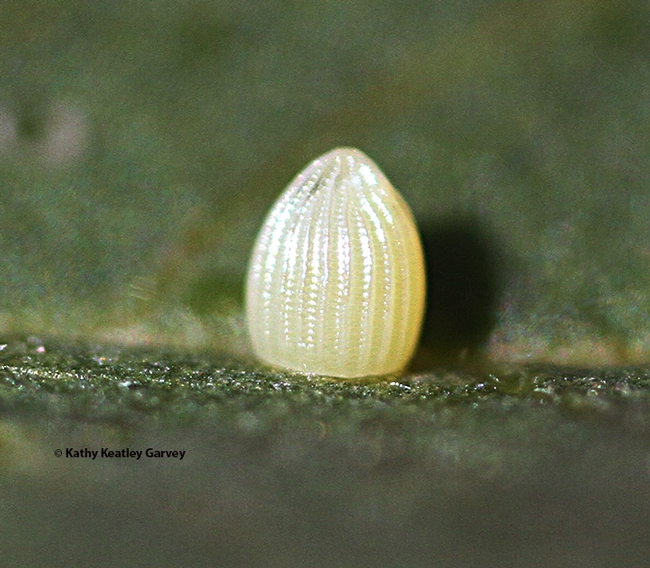
This is a close-up of a monarch egg, taken with a Canon MPE-65mm lens. It is about the size of a pinhead. (Photo by Kathy Keatley Garvey)
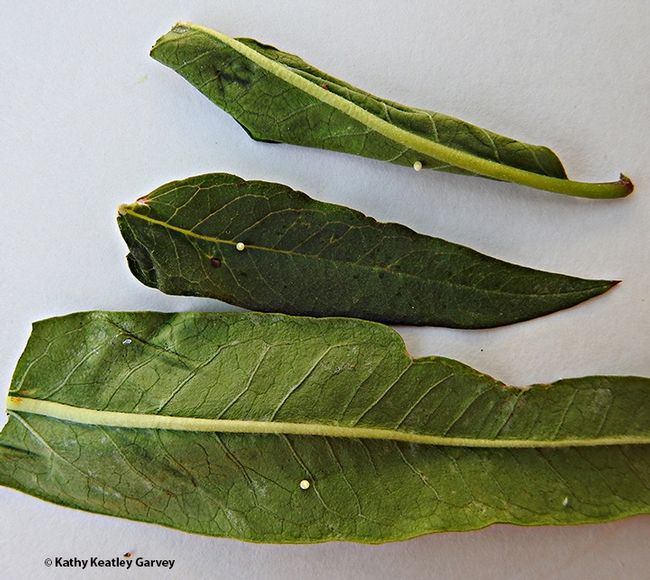
Three monarch eggs, one on each milkweed leaf (tropical milkweed Asclepias curassavica). (Photo by Kathy Keatley Garvey)
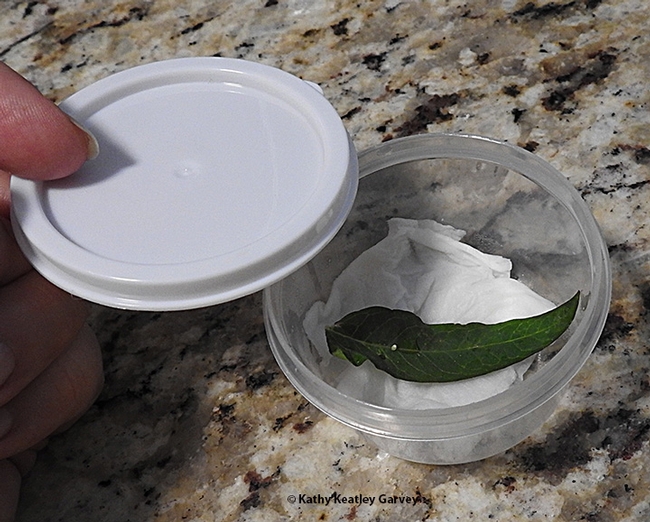
This is the small container that the Garvey family uses to rear monarch eggs. It is about 2 inches wide. (Photo by Kathy Keatley Garvey)
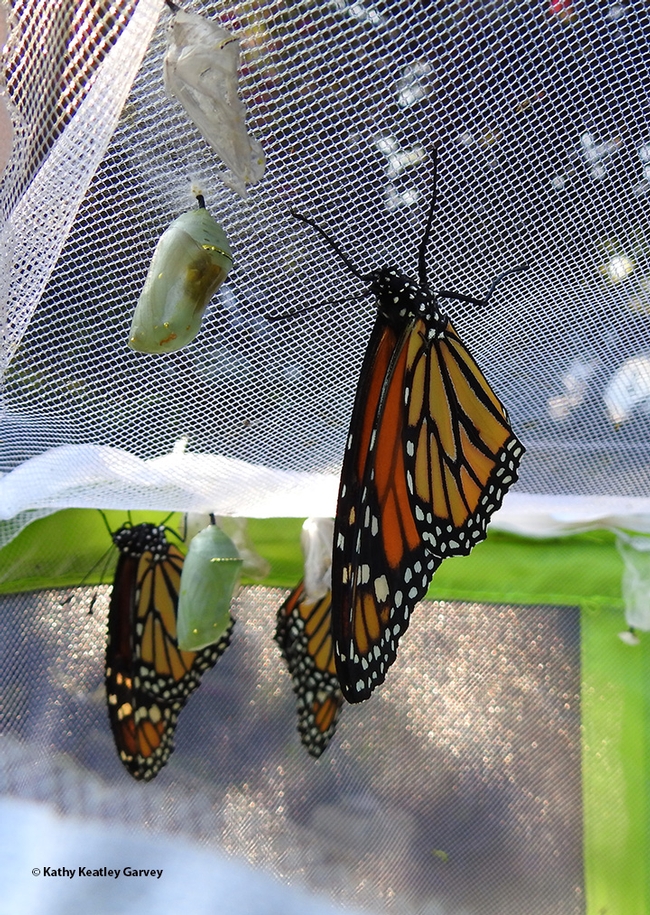
Be aware that if you collect a monarch caterpillar or chrysalis, it may already be parasitized. It is better to start with the egg, says Bohart Museum of Entomology associate Greg Kareofelas. Note the tachinid-infested chrysalis (brown spot). This image, taken in July 2020, shows two chrysalids and three newly eclosed monarchs. (Photo by Kathy Keatley Garvey)
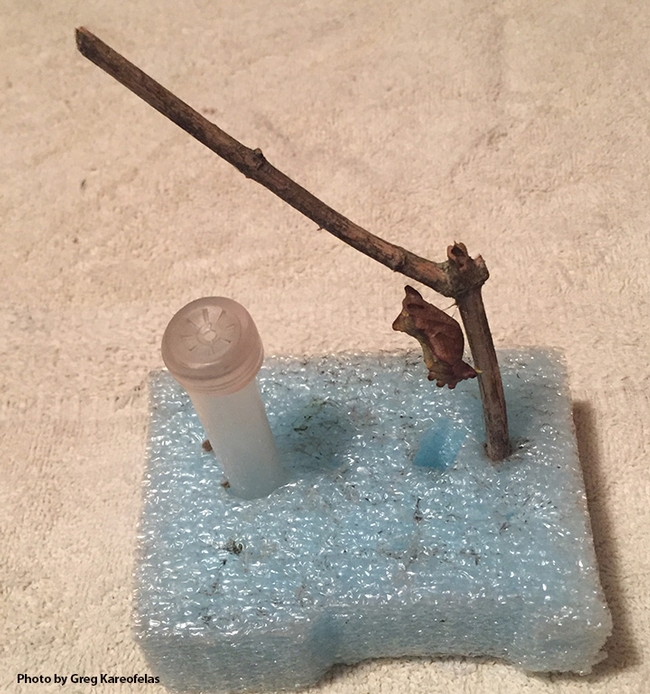
This is part of the Greg Kareofelas setup to rear butterflies. He rears many species. Note the packing foam and chrysalis (not a monarch). (Photo by Greg Kareofelas)